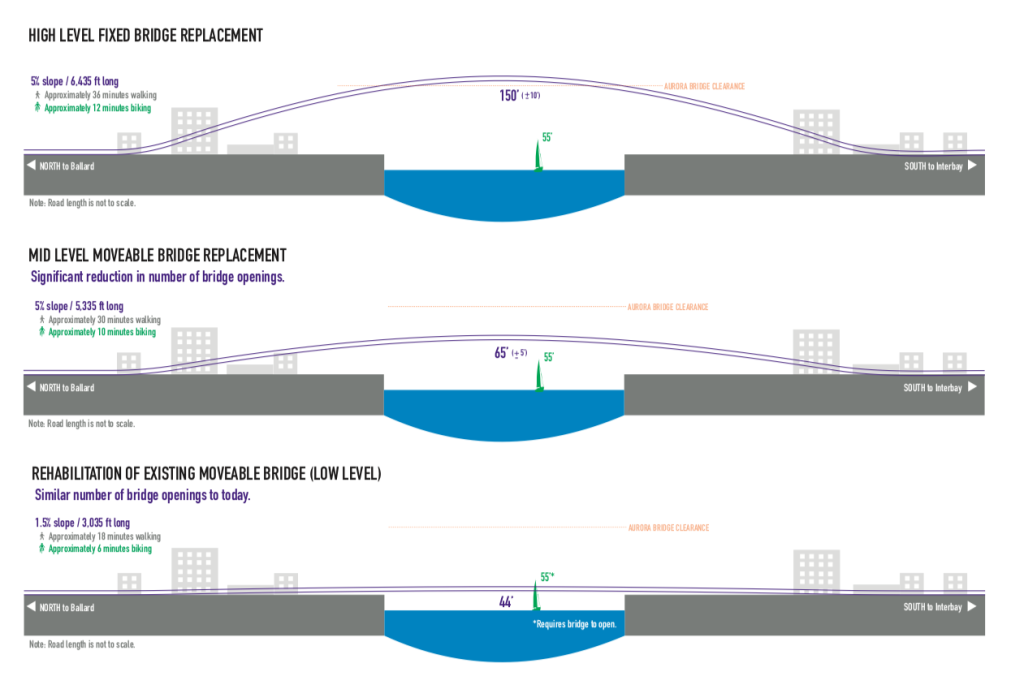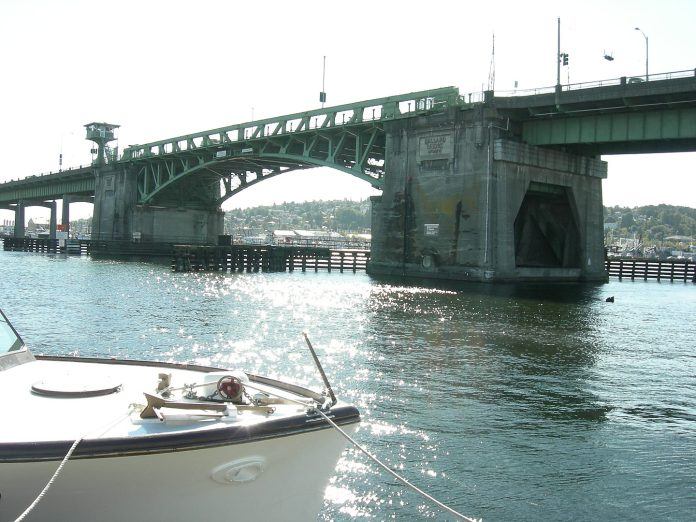Over the summer, separate surveys and public meetings discussed replacing the Magnolia Bridge, replacing the Ballard Bridge, replacing the BNSF Railway‘s Salmon Bay Bridge, running light rail to Ballard, examining the viability of golf at Interbay, and moving the Interbay Armory. In that same time, there have been closures and repairs to the Aurora bridge, Emerson Street, and the Ballard Locks, as well as construction of the Burke-Gilman Trail on Market Street from the Ballard Locks to 24th Avenue. It’s been busy.
So it’s easy to understand how something as simple as a couple trees can get lost in the shuffle. I noticed these particular trees when the rebuilt Taco Time opened at the 3000 block of Market Street. Brand new trees, about ten feet tall, in the newly laid sidewalk around the restaurant. As part of any permit process, the builder has to put in required landscape before the building opens. Taco Time dutifully installed those trees.
But the Burke-Gilman Trail was coming through. So within weeks of the new trees being installed, they were ripped out and the new sidewalk ground down.
I worked in local planning and permits for a long time. One thing I tried really hard to do was take a slightly larger view of things in an effort to avoid wastefulness. If a development project coincided with some road widening, we’d have the developer hold off on the landscaping. The trees would go up, just after the road was done.

That sense of wastefulness–in wasted money, wasted time, and wasted opportunity–is arising in the project to replace the Ballard Bridge. Following up on one of those summer meetings, the Seattle Department of Transportation (SDOT) is holding two open houses and looking for feedback on the three alternatives they are considering. Unfortunately, there are not really three alternatives. There is only three shades of one wasteful idea.
Ballard Bridge sits at the crux of a small, tightly integrated knot of rivers, roads, and rails. Together with the Ballard Locks, the BNSF railway, and eight other bridges, they are the crucial links that tie Seattle to the world, tie together neighborhoods, and make the whole city run. These infrastructure links also share three other characteristics. None of the links are transit or pedestrian ready. None of the links are ready for earthquakes or climate change. And there is no significant coordination between these projects.
A big block to coordination is authority. Aurora Bridge is under the Washington State Department of Transportation, but separate from the ST3 light rail extensions. The Interbay Armory work is a coordination between the Washington State Department of Commerce and the National Guard. BNSF is its own privately-owned entity, so its bridge only needs approvals, not funds. The Ballard Locks are domain of the Army Corps of Engineers, who also get to comment on structures crossing the ship canal (but have no money to help pay for them). And everything else is a Seattle road or park, but depends on approvals and funds from everyone else.
Also, some of the lack of coordination is a “pots of money” problem. Funds for repair or replacement for each bridge or road are coming from different sources on very different schedules. Officials say they cannot coordinate the Ballard Bridge replacement with light rail, even though they are essentially the same discussion in the exact same place. ST3’s money is dedicated already, while the bridge replacement is very preliminary. Two separate pots of money, so they cannot mix or mingle.
And that is where the one wasteful idea for the replacement Ballard Bridge comes in. Without being able to expand beyond a very tight little box, consultants and the Seattle Department of Transportation are left asking a single question: how high do your cars want to go? They offer three options.
- Go the same height on a drawbridge, constructed identical to the existing bridge and with the same number of openings to allow ships to pass.
- Go a little higher on a drawbridge, with a closed height 20’ higher than the current bridge. This would allow most smaller boats to pass and reduce the number of openings.
- Go a lot higher on a fixed bridge. This would be tall enough to eliminate the need for a drawbridge, about the height of Aurora.
These are not real options. There is nothing that creates transit only lanes. There is nothing that addresses neighboring light rail. There is nothing that makes strong ties to the bike trails on either side of the water. The Ballard Bridge is a notorious pinch point for people biking, walking and rolling–one that discourages people from using the bridge since it’s so dangerous, unpleasant, and cumbersome. The sidewalks are too narrow.

Most significantly, changes to the connection between the Ballard Bridge, Emerson Street, and Nickerson Street off the table. This horrible intersection cannot be changed as part of the bridge project. The concern is changing the intersection would interfere with Dravus Street further south, so the City is just abandoning any discussion. However, you can’t make a bridge taller without making it longer. Pinning the south end means the higher options would move the Ballard end of the bridge further north.
The highest option would put the northern end of the bridge at Market Street. It is impossible to overstate how disastrous it would be to have a massive automobile and truck bridge land in the middle of the vital and busy neighborhood with all the bus lines and the new light rail station. Think about crossing Mercer Street at Boren Avenue to get on a bus or shop at Ballard Market. This would be a disaster for pedestrian safety and neighborhood connection and it would extend any pedestrian or bicycle trip over the new bridge by almost a half mile.
That is where the walled-off thinking becomes wasteful. By putting so many constraints on this important project, the City is setting up a situation where the new bridge will inherit many of the problems of the old, with plenty of new issues added on top. By preserving the old silos between agencies, we will need to build twice as many bridges to get cars and light rail to the same places, with double the wasteful delays, costs, and construction headaches. By preserving 15th Avenue as a highway, we will waste the connections to bike trails and the potential to safely walk across Ballard Bridge. By wasting the chance to fix the knotted exits at Nickerson and Emerson, we will add a new impassable intersection at Market Street. By keeping up the walls, we waste the chance to envision something better.
Simply rebuilding Ballard Bridge will be wasted money, wasted time, and wasted opportunity. Ballard Bridge must be replaced with something better. The new bridge can serve our community and our city beyond being just another path for cars. The new Ballard Bridge can fit the pedestrian neighborhoods it connects; can live up to the Green New Deal and Vision Zero promises that the City is making; and can coordinate and improve upon the many other projects nearby.
To do otherwise would be like planting trees in a sidewalk about to get ripped out. We’ll see you at the meetings this week.
- Peddler Brewing Company – October 24
1514 NW Leary Way, 98107
Thursday, October 24, 6-7:30pm - Fishermen’s Terminal – October 29
Seattle Fishermen’s Memorial Plaza
3919 18th Ave W, 98119
Tuesday, October 29, 6-7:30pm
Ray Dubicki is a stay-at-home dad and parent-on-call for taking care of general school and neighborhood tasks around Ballard. This lets him see how urbanism works (or doesn’t) during the hours most people are locked in their office. He is an attorney and urbanist by training, with soup-to-nuts planning experience from code enforcement to university development to writing zoning ordinances. He enjoys using PowerPoint, but only because it’s no longer a weekly obligation.


